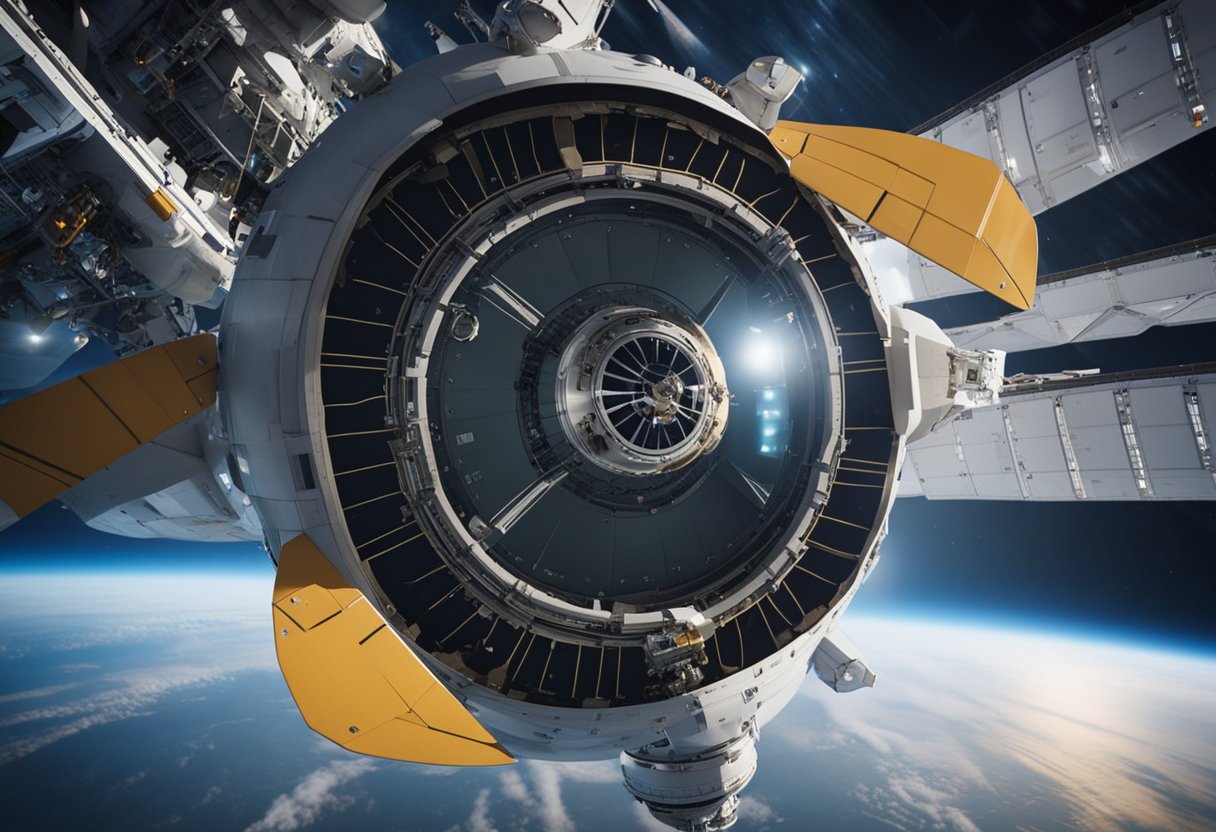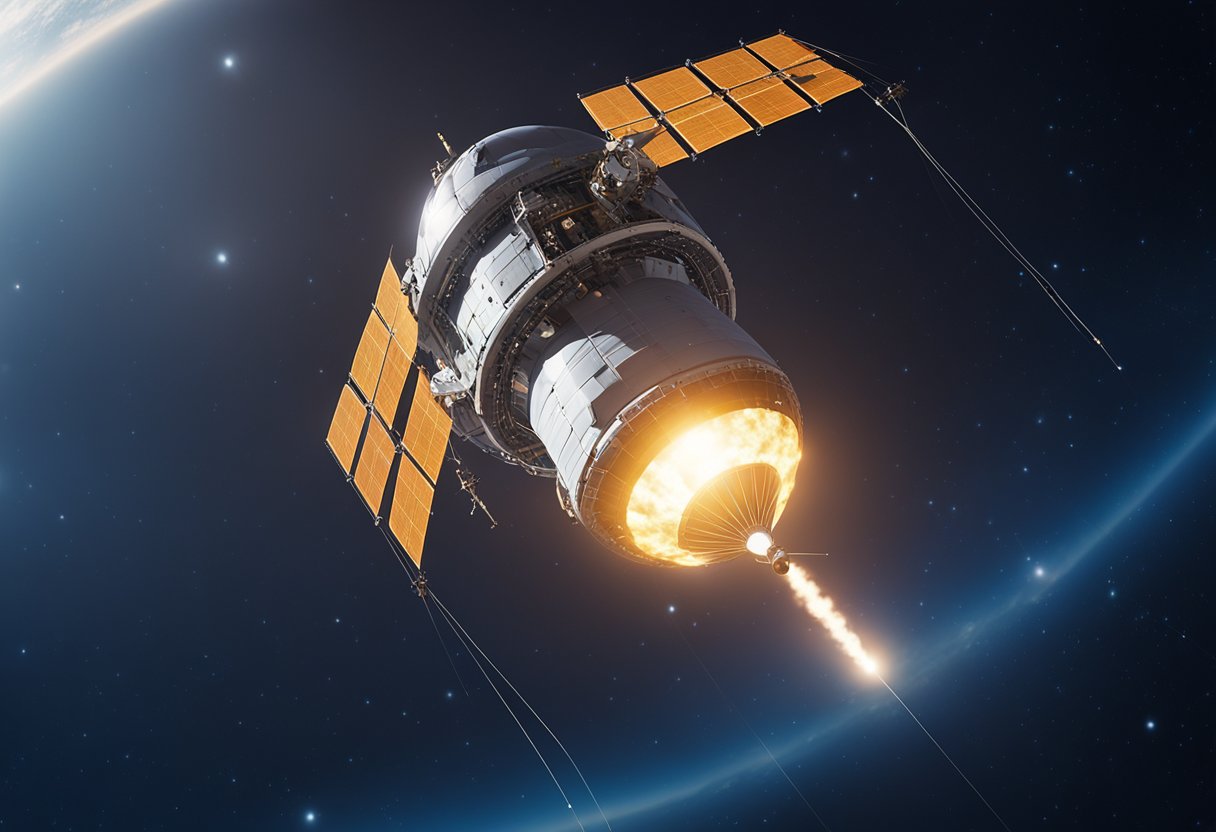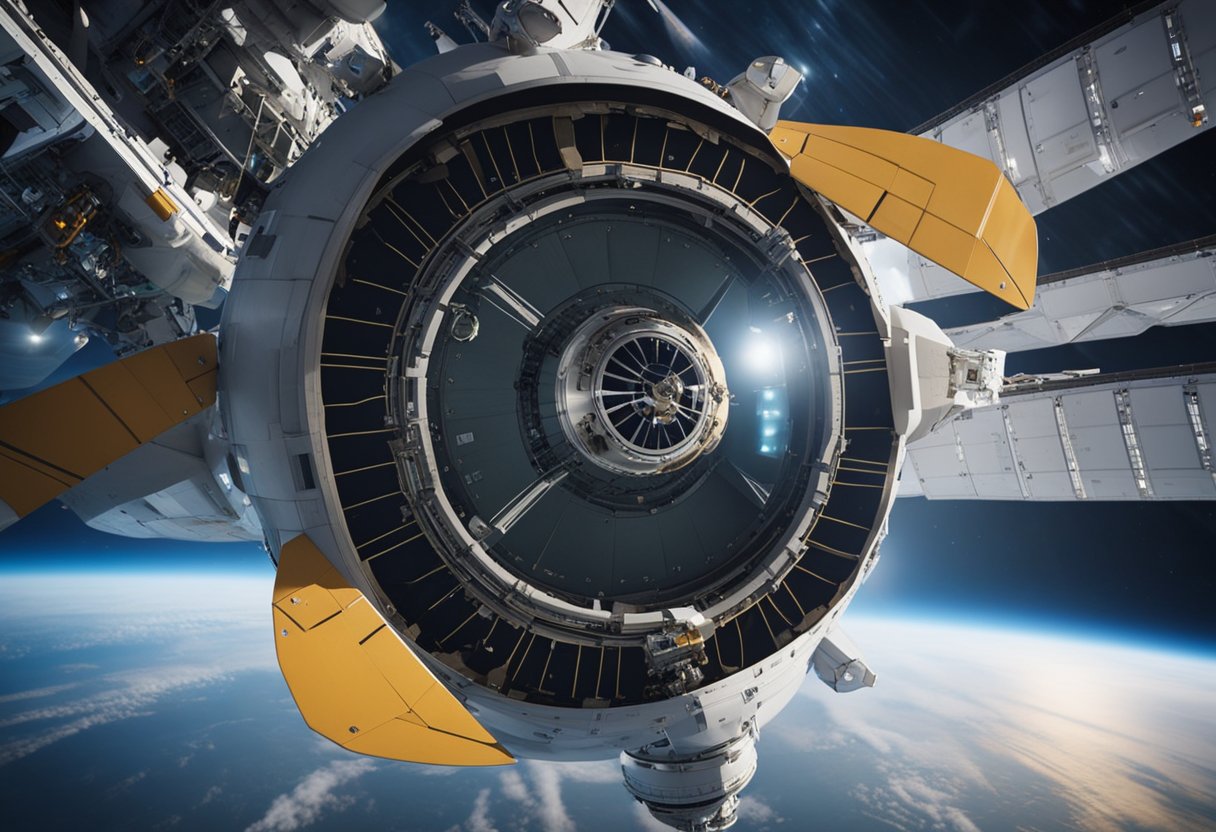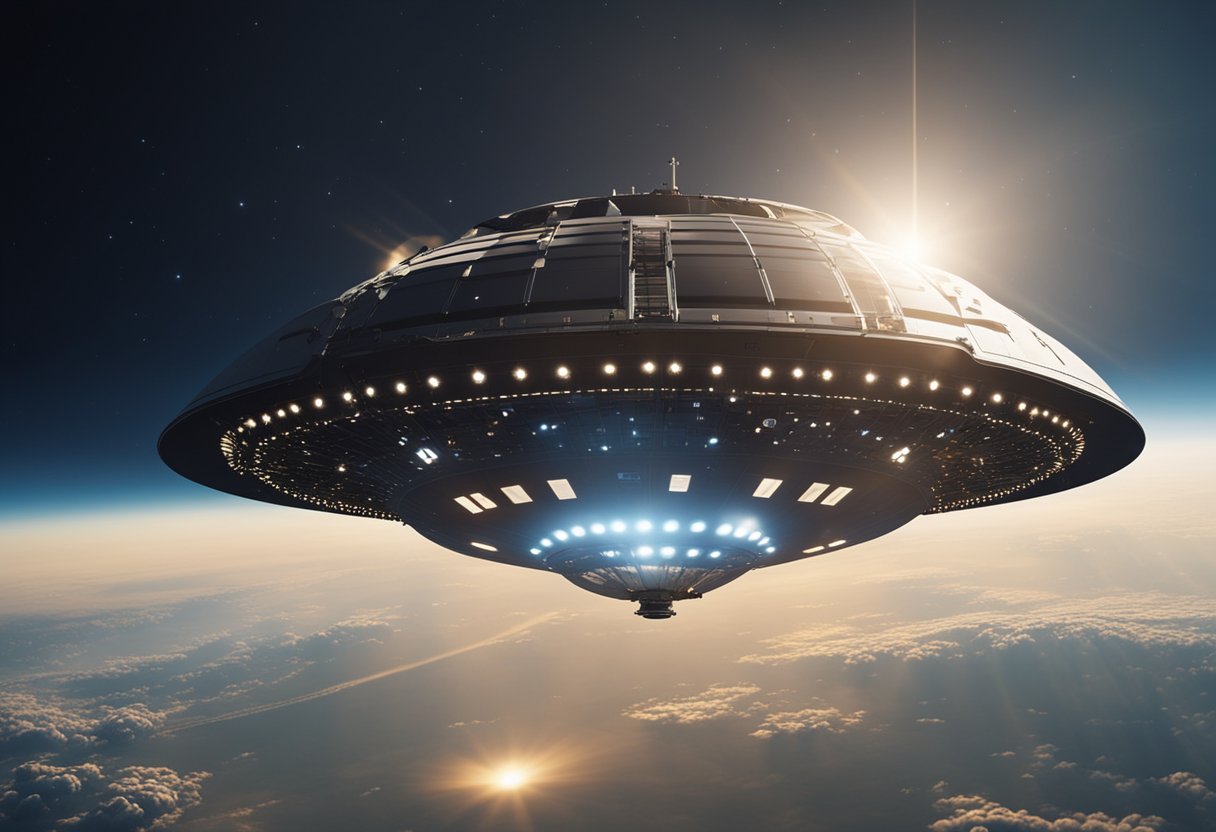
Re-entry and landing procedures are critical phases in the journey of a spacecraft returning to Earth. During re-entry, a spacecraft transitions from the vacuum of space to the atmospheric environment of Earth, presenting unique challenges in thermal management, aerodynamics, and material science. The narrow re-entry corridor ensures a spacecraft enters the atmosphere at just the right angle — too steep and the craft may burn up, too shallow and it may skip off the atmosphere and back into space. It is a delicate manoeuvre that requires precise calculations and timing to achieve a safe return.

Once through the upper layers of the atmosphere, the spacecraft must slow down enough to safely deploy any landing systems. Depending on the design, a spacecraft might splash down in an ocean, land on a runway like an aeroplane, or use retrograde rockets to perform a vertical landing. Throughout this process, guidance, navigation, and control systems are critical in ensuring the spacecraft follows the intended path, while communication and telemetry systems must maintain the flow of data between the spacecraft and mission control. Post-landing operations are also a significant aspect, including the safe recovery of the spacecraft and crew, plus any necessary environmental cleanup or noise mitigation.
We need to appreciate the pivotal moments in space travel that have structured our contemporary approach to re-entry and landing. Each milestone in this journey has harnedd lessons learned from its predecessors, shaping a safer and more precise process for bringing spacecraft back to Earth.
During the Space Race, it was the Apollo missions that established a foundation for controlled re-entry and landing. NASA meticulously engineered the Apollo spacecraft to withstand the harsh conditions of Earth’s atmosphere during re-entry and facilitated precision landing, mainly in the ocean. Notably, Apollo 11 was a landmark mission, culminating in the first manned moon landing and subsequently returning the astronauts safely back to Earth.
The inception of the Space Shuttle program marked a significant evolution in spacecraft design. The shuttles were the first to be utilised for multiple missions, introducing reusable vehicles with more complex re-entry and landing requirements. NASA’s Space Shuttle could glide back to a predetermined runway, marking a departure from the previous era’s splashdowns. This advancement led us to more sophisticated landing techniques that are in use even today.
Our knowledge of these historical contexts isn’t just about looking back. With companies like SpaceVoyageVentures.com aiming to make space more accessible, we’re applying our collective history to usher in an era where space travel might become nearly as routine as air travel.
Re-entering Earth’s atmosphere from space is a complex process, governed by physics principles that ensure the spacecraft resists extreme temperatures and velocities. Let’s explore the key aspects.
Upon re-entry, a spacecraft encounters the Earth’s atmosphere at speeds that can exceed Mach 25. At these high velocities, the spacecraft compresses the air in front, which in turn heats up tremendously. This interaction with the atmosphere generates a significant amount of drag, which is crucial for slowing down the spacecraft without the use of fuel.
The thermal protection system, including heat shields, is fundamental during re-entry. The shield, often a blunt body design, dissipates heat by ablation or reflection, protecting the craft from temperatures that can reach around 1,650 degrees Celsius. Proper heat management is critical to ensure the integrity of both the spacecraft and the safety of its contents or crew.
Planning the re-entry trajectory is a meticulous process. It requires precision to manage the aerodynamic forces for a stable descent and to ensure the spacecraft lands at the intended target. Effective aerodynamic design helps to balance lift and drag, enabling control over speed and angle of descent, minimising the g-forces experienced by the passengers and spacecraft alike. Our mastery in the understanding of these principles is what allows us to contemplate ventures such as the ones documented on SpaceVoyageVentures.com.
Re-entry vehicles are pivotal in our journey through space, responsible for the safe return of astronauts and payloads to Earth. Their design and performance are testament to decades of innovation and international cooperation.
Apollo: We count the legendary Apollo missions as our early forays into crewed spaceflight, with the Apollo spacecraft setting the benchmark for re-entry procedures. Apollo’s conical capsule is renowned for pioneering the guidance and control techniques required to navigate through Earth’s atmosphere, protect the crew from intense re-entry heat, and ensure precise landings, often in the ocean.
Space Shuttle: The iconic Space Shuttle, a testament to our ingenuity, expanded the horizons of what a re-entry vehicle could do. Unlike the Apollo, it was a winged orbiter, allowing for controlled landings on a runway, similar to an aeroplane. The Shuttle’s heat shield tiles exemplified a new approach to thermal protection during the fiery descent.
Orion: More recently, we’ve been developing the Orion spacecraft. With sights set beyond low Earth orbit, Orion promises to sustain human exploration of the Moon and beyond. Our advances ensure improved safety and versatility, with Orion’s design drawing from Apollo’s robust architecture, updated with modern technology to face contemporary space launch challenges, including those posed by the powerful SpaceX Falcon 9 and Blue Origin rockets.
Soyuz: The Russian Soyuz spacecraft deserves our recognition for its decades of reliable service in crewed spaceflight. Showcasing a capsule design, Soyuz continues to facilitate transport to and from the International Space Station (ISS), demonstrating an admirable legacy of safety in returning cosmonauts to Earth.
Shenzhou: On the global stage, we’ve also witnessed China’s emergence in space exploration with their Shenzhou spacecraft. Emphasising crew survival and mission success, the Shenzhou uses a re-entry module similar in its blunt body design to the vehicles of our spacefaring history but with modern updates tailored for contemporary missions.
Our collective endeavours in developing re-entry vehicles undeniably mark the progression of our capabilities, from the founding flights of Apollo, through the shuttle era to the diversified and international fleet comprising Soyuz, Shenzhou, and the foreseen successors. Our expertise is also evident as we shape the space tourism industry, where ventures like SpaceVoyageVentures.com detail current and future space travel experiences, contributing to the framework for safe and accessible space journeys.
When planning the return journey of a spacecraft, we focus on how the vehicle will tolerate intense atmospheric heat and the structural demands of re-entry. These are the cornerstones of safe and successful return missions.
The design of thermal protection systems (TPS) is pivotal in withstanding the severe heat flux experienced during atmospheric entry. One prevalent solution is ablative heat shields, which erode away as they absorb and dissipate heat. This effectively keeps the intense heat from reaching the vehicle’s interior and maintains structural integrity.
Engineers may also utilise reinforced carbon-carbon (RCC) for critical, high-temperature areas like the nose cap and wing edges. Our mastery of these materials directly impacts the safety and longevity of the spacecraft. Finding an optimal angle of attack is crucial—this not only influences the heat experienced but also the vehicle’s controllability.
We select structural materials for their strength, thermal resistance, and durability under the stresses of re-entry. These materials must also be as lightweight as possible to boost efficiency and reduce launch costs. The challenge we face is finding materials that withstand multiple re-entries without compromising safety, a task that has led to the evolution of materials technology in aerospace design.
In our designs, careful consideration goes into the application of materials like RCC and advanced composites, which play an essential role in the vehicle’s thermal stability and structural performance. By pushing the boundaries of engineering, we aim to craft vehicles that not only safeguard their passengers but also promise repeated use—a necessity for the burgeoning field of space tourism as highlighted by SpaceVoyageVentures.com.

In our discussion of spacecraft re-entry and landing procedures, we focus on critical components such as landing systems and gear, which are integral for safe touchdown and recovery.
Parachute systems are pivotal during the re-entry phase for spacecraft and sometimes aircraft, ensuring both safety and control as they approach Earth. A parachute assisted landing typically involves the deployment of one or more parachutes to slow the descent of the vehicle post-re-entry for a safe splashdown or land touchdown. This procedure often involves a series of parachutes, starting with a drogue chute to stabilise and decrease speed, followed by main parachutes to further decelerate the vehicle for safe recovery.
Beyond parachutes, other landing systems and gear are critical for the variety of available and near-future space tourism experiences detailed on SpaceVoyageVentures.com. One alternative method employed by some spacecraft is the use of retropropulsion, where rockets are used to slow down the vehicle before landing. This method can provide a precise landing on solid ground rather than a splashdown. Another emerging technology is airbags, which cushion the impact for vehicles landing on harder surfaces. The viability and reliability of the landing gear systems are of utmost importance for the safety and success of the mission and for the swift recovery of both the vehicle and its occupants.
In spacecraft re-entry and landing, Guidance, Navigation, and Control (GNC) systems are essential for a safe descent. They ensure that the spacecraft follows the intended trajectory, manages its speed, and aligns correctly with the landing site.
Our flight control systems involve an intricate network that synchronises the spacecraft’s orientation, stabilisation, and propulsive capabilities. Aerodynamic control surfaces and thrusters work cohesively to adjust the flight path and maintain stability. The use of robust full state feedback LQR-based tracking algorithms allows precise control over the spacecraft’s manoeuvres during its re-entry phase.
For targeting the desired de-orbit location, a reliable algorithm is necessary to compute the correct aerodynamic drag profile. We utilise customised Extended Kalman Filter (EKF) algorithms for accurate relative state estimation—a crucial component for the spacecraft’s guidance capabilities. This methodology underpins our ability to guide the craft through complex re-entry paths, ensuring a pinpoint landing.
We place importance on the delicate balance between crew inputs and autonomous controls. The spacecraft’s GNC system is designed to allow manual interventions by the crew when necessary but retains a substantial degree of autonomy to handle unexpected situations or to relieve the crew from routine flying tasks. Our advanced systems help to mitigate the risks associated with human error, fatigue, or incapacitation.
By meticulously deploying these systems, we endeavour to provide safe and reliable travel through space, supporting current missions as well as the aspirations of space tourism enterprises such as SpaceVoyageVentures.com. Our commitment is to pursue excellence in our GNC technologies, meeting the complex demands of space travel as we progress into the future.
In the critical stages of spacecraft re-entry and landing, communication and telemetry are essential tools for tracking and controlling the mission. These systems relay back to Earth vital data on the spacecraft’s status.
We employ a series of ground-based and orbital tracking stations to monitor the spacecraft’s descent, using radar and other instruments. Space agencies such as NASA, ESA, and their counterparts in China and Japan maintain a network of facilities worldwide to provide continuous observation and telemetry data retrieval throughout the mission’s critical phases. This telemetry includes everything from altitude and speed to the spacecraft’s systems health, which is crucial for mission control’s decision-making.
Communication Satellites: For missions beyond low Earth orbit, such as those to the Moon or Mars, the use of communication satellites like NASA’s Mars Reconnaissance Orbiter significantly enhances our monitoring capabilities, although challenges remain in keeping robust communication links during entry and descent. The design of these links must handle uncertainties in the trajectory and requires extensive modelling.
A communication blackout occurs when the spacecraft enters the plasma phase of re-entry, preventing radio signals from reaching Earth. During this time, no data transmission is possible, prompting us to rely solely on pre-planned procedures and spacecraft autonomy. Historically, blackouts last for several minutes; however, advanced computational models and simulations are helping us to predict and mitigate the impact on communication links.
Blackout Mitigation: To address blackout periods, our teams develop strategies that involve both hardware design and operational procedures. This includes the careful positioning of antennas and the use of materials on the spacecraft that can withstand the intense heat generated during re-entry, while still allowing for some degree of transmission when possible.
The transition from re-entry to landing is a critical phase where we see a dramatic decrease in velocity and the shift from relying on the spacecraft’s aerodynamics to the deployment of landing apparatus such as parachutes.
During the re-entry phase, our spacecraft initially encounters the Earth’s atmosphere at hypersonic speeds. We employ various speed reduction techniques to safely transition to subsonic speeds before landing. One key method includes the use of a speed brake, a device that increases the vehicle’s drag to effectively slow it down. By carefully manipulating the speed brake, we can precisely control the airspeed, ensuring that the spacecraft slows down at the required rate to prevent structural or thermal damage.
A pivotal moment in this phase is when the vehicle reaches subsonic speeds, which are typically below Mach 1. At this point, the behaviour of the spacecraft closely resembles that of a conventional aircraft, allowing for more familiar control dynamics and easier handling by the pilot.
Once we’ve successfully reduced our speed to within a safe range, we prepare for the final descent. Depending on our vehicle’s design, this could involve a gliding descent similar to that of traditional planes, or the deployment of parachutes. Parachute deployment is a crucial step in the landing sequence, with the parachutes fully deploying at the designated altitude to ensure a gentle touchdown.
The parachutes deploy in a staged fashion, initially releasing small drogue chutes that stabilise and add drag, followed by the main parachutes that bring the spacecraft to a gentle glide. Throughout this stage, we closely monitor the airspeed and environmental parameters to make real-time adjustments, ensuring a smooth and controlled return to Earth.
Following the successful landing of a spacecraft, certain crucial operations must be promptly executed to ensure the safety of the crew and the integrity of the vehicle.
After touchdown, our immediate priority is the safe extraction of the crew. Recovery teams at the Kennedy Space Centre or designated landing area swiftly mobilise to the landing site. Coordination with NASA ensures that medical personnel and support staff are prepared for any contingencies. Personnel conduct thorough checks to guarantee the stability of the landed module before opening the hatches. Once cleared, astronauts are assisted out of the craft and given initial health checks.
Ensuring the vehicle is secure and poses no danger to recovery teams or the crew forms the subsequent phase. We methodically deactivate spacecraft systems, a task that involves the careful handling of propellants and power sources. This operation is critical, especially for spacecraft like those returning propellantless, which must be managed to prevent inadvertent activation of systems. Cargo, both scientific and operational, is safely unloaded, often including materials sensitive to Earth’s gravity and atmosphere after being in microgravity. The vehicle is then prepared for transport or refurbishment, following a rigorous safety protocol established in guidance documents.
As we explore the intricacies of re-entry and landing, it is imperative to acknowledge the environmental implications, chief among them are the acoustic disturbances, such as sonic booms, and the safety concerns within the landing zone.
During the re-entry phase, as vehicles descend from low Earth orbit or return from the moon, they must breach the upper atmosphere at velocities exceeding the speed of sound. This penetration causes shockwaves to proliferate, manifesting as sonic booms. These phenomena can be quite jarring on the ground, particularly because the energy from the shockwaves creates powerful sound waves that can impact both wildlife and human communities. Efforts to mitigate such disturbances include engineering designs that aim to minimise the impact of sonic booms by altering the shape of air vehicles to disrupt the pattern of shockwaves.
The environmental safety of the designated landing zones is also crucial. As spacecraft enter back into the Earth’s atmosphere, they generate extreme heat due to friction—creating plasma around the vehicle that can reach temperatures high enough to compromise the structural integrity of unprotected materials. Ensuring the safe dispersal of this heat to protect both the vehicle and the landing area requires precise calculations and robust heat shield technology. Moreover, when determining a suitable landing area, it is essential to consider potential hazards such as densely populated regions or sensitive ecological zones, to safeguard against any negative impacts on the environment or the populace.

In the pursuit of advancing space exploration, significant emphasis is being placed on refining re-entry and landing technologies. We are witnessing an evolution in materials science and flight formation strategies that aim to enhance the safety, precision, and efficiency of future spacecraft.
Heat shields are critical for ensuring spacecraft can survive the intense heat generated during atmospheric re-entry. Our ongoing research seeks to reduce the ballistic coefficient, enhancing stability and minimising heat strain. We are exploring new materials with higher melting points and better thermal resistance, which promise to revolutionise this domain.
Having multiple spacecraft execute simultaneous re-entries poses complex challenges in terms of formation flying and propulsion coordination. Our development of algorithms for controlled descent enables these spacecraft to land in fleets, thereby optimising the recovery process and ensuring precise landings. This formation approach not only contributes to the stability of individual spacecraft but also opens up new possibilities for space tourism as outlined on websites like SpaceVoyageVentures.com.
In this section, we’ll clarify some common queries related to the technical aspects of space shuttle re-entry and landing procedures.
It generally takes about an hour for a space shuttle to go from the upper layers of the atmosphere to landing on the Earth’s surface. This time frame involves the intense phase of atmospheric re-entry as well as the gliding and landing procedures.
The optimal angle of attack for a spacecraft during atmospheric re-entry is typically between 40 and 45 degrees. This angle is crucial for managing the heat distribution and ensuring the structural integrity of the shuttle.
A slow re-entry speed is not feasible due to the need for spacecraft to shed the immense velocity acquired in orbit. Entering too slowly would require an extended period within the atmosphere, leading to sustained heat exposure which could compromise the spacecraft’s shields and structure.
The temperature during re-entry is calculated using predictive models that consider the spacecraft’s velocity, atmospheric density, and the heat resistance of the materials used. These calculations help in designing effective thermal protection systems.
Procedures for a successful return to Earth include the orientation of the shuttle for re-entry, the deployment of thermal resistant shields, controlled descent through the atmosphere, and the activation of parachutes and other landing gear to ensure a safe touchdown.
The high re-entry speed is an inherent result of the kinetic energy that must be dissipated for the spacecraft to transition from an orbital path to a landing trajectory. This immense speed helps in achieving a balance between the gravitational pull and the aerodynamic forces needed for a stable descent.